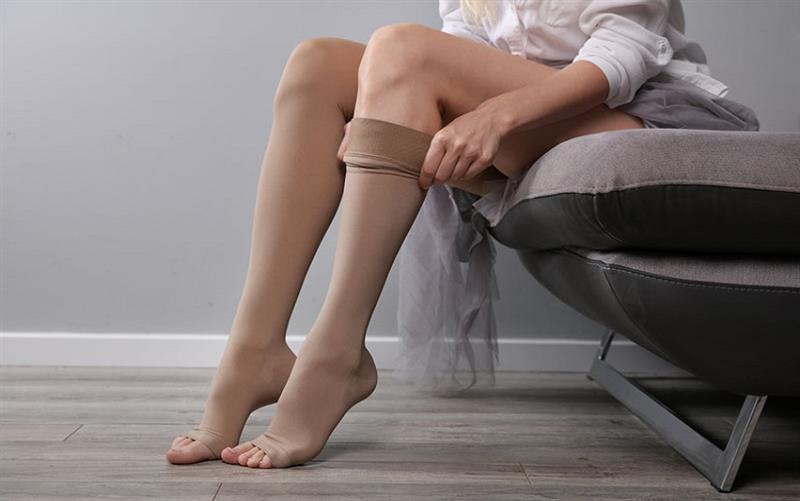
Compression socks are a simple yet highly effective way to protect yourself from DVT and improve your overall comfort during long flights. By enhancing blood circulation, reducing swelling, and providing essential leg support, these socks can be a travel game-changer. Next time you’re preparing for a journey, consider adding compression socks to your travel essentials.
Long flights can be a thrilling gateway to new adventures, but they also come with their own set of health risks. One such risk is Deep Vein Thrombosis (DVT), a condition that occurs when blood clots form in the deep veins, typically in the legs. DVT can be life-threatening if the clot travels to the lungs, causing a pulmonary embolism. However, there is a simple, effective measure to mitigate this risk: wearing compression socks.
What is Deep Vein Thrombosis (DVT)?
Deep Vein Thrombosis is a serious condition that results from blood clotting in the deep veins of the body. Prolonged immobility, such as during long flights, can slow blood flow in the legs, increasing the risk of clot formation. Symptoms of DVT can include swelling, pain, and redness in the affected limb, but in many cases, it can be asymptomatic.
How Compression Socks Work
Compression socks are specially designed to apply pressure to your legs, helping your blood vessels work more efficiently. The graduated compression, which is tighter at the ankle and gradually decreases up the leg, promotes blood flow back to the heart and reduces the risk of blood pooling and clotting.
Benefits of Wearing Compression Socks During Flights
1. Enhanced Blood Circulation:
Compression socks help maintain healthy blood circulation during long periods of inactivity. The gentle pressure they apply encourages blood to flow back towards the heart, reducing the risk of clots forming in the legs.
2. Reduced Swelling and Discomfort:
Prolonged sitting can cause your feet and legs to swell, leading to discomfort. Compression socks help reduce this swelling by preventing fluid accumulation in the tissues.
3. Prevention of Blood Clots:
By improving circulation, compression socks significantly lower the risk of DVT. This is particularly crucial during long flights where movement is restricted, and the risk of clot formation is higher.
4. Improved Comfort:
Modern compression socks are designed with comfort in mind. Made from breathable, moisture-wicking materials, they keep your legs cool and dry, ensuring you stay comfortable throughout your flight.
5. Support for Varicose Veins:
Compression socks can help manage varicose veins by reducing the pressure in the veins, decreasing the risk of developing new varicose veins and easing discomfort from existing ones.
6. Prevention of Leg Fatigue:
Long periods of sitting can lead to muscle fatigue in the legs. Compression socks provide support to the muscles, reducing the feeling of tiredness and heaviness.
7. Enhanced Athletic Performance and Recovery:
For athletes, wearing compression socks during flights can aid in faster recovery by reducing muscle soreness and promoting quicker removal of metabolic waste products from the legs.
8. Temperature Regulation:
Many compression socks are made with materials that help regulate temperature, keeping your legs warm in cold cabin environments and cool when it gets warmer.
9. Reduced Risk of Edema:
Compression socks help prevent fluid retention in the legs, reducing the risk of edema (swelling caused by excess fluid trapped in the body’s tissues).
10. Increased Energy Levels:
By improving circulation and reducing leg fatigue, compression socks can help you feel more energetic and less sluggish during and after your flight.
Who Should Wear Compression Socks?
While anyone can benefit from wearing compression socks during long flights, they are especially recommended for individuals at higher risk of DVT. This includes:
- People with a history of blood clots or DVT.
- Individuals with cardiovascular conditions.
- Pregnant women.
- Older adults.
- Those who have recently undergone surgery.
- People who are overweight or obese.
Choosing the Right Compression Socks
When selecting compression socks, it's important to consider the level of compression and the fit. Compression levels are measured in millimeters of mercury (mmHg) and typically range from mild (15-20 mmHg) to moderate (20-30 mmHg) and firm (30-40 mmHg). For most travelers, a mild to moderate level of compression is sufficient. However, individuals with existing health conditions should consult their healthcare provider for personalized recommendations.
Additionally, ensure the socks fit well and are comfortable. They should be snug but not too tight, and made from materials that allow your skin to breathe.
Tips for Wearing Compression Socks on Flights
1. Put Them On Before You Fly:
Wear your compression socks before you board the plane. It's easier to put them on when your legs are not yet swollen.
2. Keep Them On Throughout the Flight:
Wear the socks for the entire duration of the flight, and for a few hours after landing to help your body adjust.
3. Stay Hydrated:
Drinking plenty of water helps keep your blood fluid and reduces the risk of clotting.
4. Move Around:
Whenever possible, take short walks along the aisle and do simple leg exercises in your seat to further promote circulation.